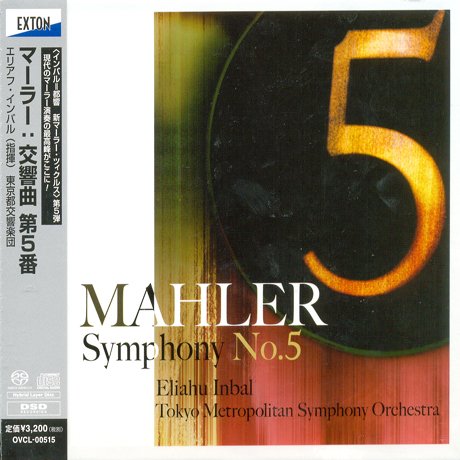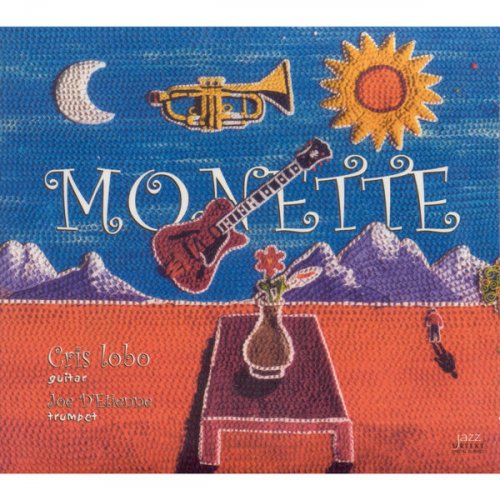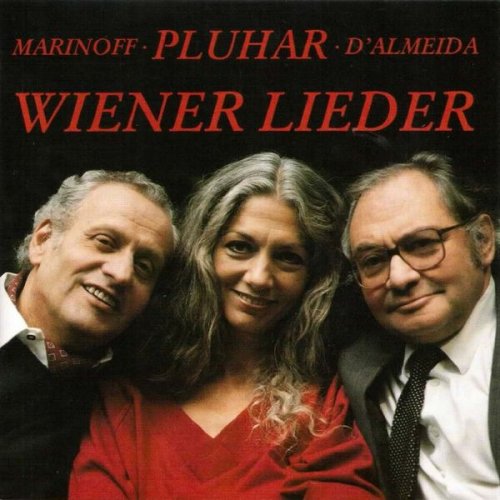Tokyo Metropolitan Symphony Orchestra, Eliahu Inbal - Mahler: Symphony No.5 (2016) [SACD]

Artist: Tokyo Metropolitan Symphony Orchestra, Eliahu Inbal
Title: Mahler: Symphony No.5
Year Of Release: 2016
Label: EXTON (Japan)
Genre: Classical
Quality: DSD64 image (*.iso) / 2.0 (2,8 MHz/1 Bit)
Total Time: 01:06:05
Total Size: 2.66 GB
WebSite: Album Preview
Tracklist:Title: Mahler: Symphony No.5
Year Of Release: 2016
Label: EXTON (Japan)
Genre: Classical
Quality: DSD64 image (*.iso) / 2.0 (2,8 MHz/1 Bit)
Total Time: 01:06:05
Total Size: 2.66 GB
WebSite: Album Preview
01. Trauermarsch. In gemessenem Schritt. Streng. Wie ein Kondukt (11:58)
02. Stürmisch bewegt, mit größter Vehemenz (13:23)
03. Scherzo. Kräftig, nicht zu schnell (17:50)
04. Adagietto. Sehr langsam (08:41)
05. Rondo - Finale. Allegro - Allegro giocoso. Frisch (14:13)
"With each new symphony - and sometimes with each new movement inside each new symphony - we are taken into a different world. In each case there is a passionate, even desperate identification with a certain attitude - but only in the last resort, for what it is worth; suddenly the scene changes and another attitude is being identified with - but again, only for what it is worth." So wrote Deryck Cooke on what another Mahler scholar, Neville Cardus, characterised as Mahler's ability to "shed a skin" with each new work. This aspect of his creative life was never more in evidence than with the arrival of the Fifth Symphony and the two symphonies that followed. The Wunderhorn-based visions and dreams of the first four symphonies that, along with first love and religious questioning, provided an escape valve and a vast comfort-zone, were replaced in the three purely instrumental works of his middle period by a clear resolve to face the realities of life. No more fairy tales, no more theology, no more overt programmes, no more voices, no more poetry. Structures are tighter and more symphonic, textures are clearer and more experimental, ideas are more uncompromising and more self-centred. There are still the vestiges of the past. No artist's creative life is neatly compartmentalised. There are Wunderhorn song analogies in two of the three works but the context has changed. Song influences in these works are now just as likely to come from Mahler's settings of poems by Freidrich Ruckert which run contemporary with them. So, with the Fifth Symphony Mahler grows up, puts away childish things and sees the world through a glass sometimes darkly sometimes not.
The Fifth Symphony presents us with the musical equivalent of a split personality. Musical polar opposites are presented side by side - tragedy and joy, depression and mania, pain and pleasure, despair and hope, etc. These opposing attitudes are held together by a tripartite structure that charts a general course out of despair towards ultimate joy but with a journey that is by no means smooth. The first two movements form Part I, the last two Part III. The third movement forms Part II by itself and it's in this movement, a huge Scherzo lasting up to twenty minutes, that the opposing forces all appear to meet and become transformed rather than resolved (resolution must wait) into what Mahler thought of as a portrait of a man of the world. So this third movement/Part II is the hub of a revolving wheel whose perimeter is the four movements making up Parts I and III and from whose revolutions fly off the opposing ideas Mahler uses as his material which the two parts either side present.
The first movement is a drastic funeral march with elegiac asides and one incredible outburst of anguish. The second movement is an eruption of furious energy punctuated by moments of utter despair and a tantalising vision of paradise and resolution before despair seems to finally win. The fourth movement is a nostalgically-charged song without words for strings and harp, the fifth a jubilant, neo-classical rondo that concludes by recalling the vision of paradise from the second movement as a true resolution that knits the disparate work together. And in the centre is that third movement with its little dance episodes, its romantic horn solos and its outbursts of benign energy. For the conductor the Fifth Symphony must pose the greatest challenge in Mahler. He must bring unity to a work that is about disunity. To make it work he must allow us to hear every aspect of it in equal measure.
The fourth movement, the much-loved Adagietto for strings and harp, is Mahler's most famous composition. Frequently heard alone on radio stations and in those compilation discs much beloved of the company marketing departments, it's probably the piece of music that introduces the name Gustav Mahler to more people than any other. Its use in the Visconti film "Death In Venice" only added to its popularity. It is, of course, an intensely beautiful piece, well-deserving fame and affection. However, I and many others believe fame and affection has taken a toll on performances in that most conductors opt to play it slower than was meant by the composer. There is no doubting its appeal when performances stretch to twelve, thirteen, even fourteen minutes. But the fact is there's strong evidence to suggest Mahler only meant it to last around seven or eight and to stretch it out robs it of its delicate magic and compromises its place in the greater scheme. Even leaving aside the evidence of contemporaries whose notes confirm a more animated interpretation (and the example on record of Mahler's disciples Walter and Mengelberg) there's the strongly-held belief this is, as Donald Mitchell suggests, a Ruckert "song without words" to be played in line with what the human voice could cope with. Performances that last anything into double figures surely fall outside that. I would only add a further point. In the fifth movement Mahler recalls the theme of the Adagietto in the way that he also does themes from the first movement in the second movement. I believe the recapitulation of the Adagietto material in the fifth movement works better the closer it sounds to the way we heard it first. Since the reprise of the material in the fifth movement is, by nature of the movement it's contained in, quicker than an Adagietto nearer to it in tempo reinforces the point Mahler is trying to make that these two movements are connected. Of course, a slow Adagietto should not rule out a recording of the symphony. As Mitchell also says: "There are occasions when the 'wrong' tempo in the right hands can convince, whereas the observe does not...." With that fact firmly in mind I still believe this question of the Adagietto's tempo should be there when considering different interpretations of the Fifth Symphony.
The Fifth Symphony presents us with the musical equivalent of a split personality. Musical polar opposites are presented side by side - tragedy and joy, depression and mania, pain and pleasure, despair and hope, etc. These opposing attitudes are held together by a tripartite structure that charts a general course out of despair towards ultimate joy but with a journey that is by no means smooth. The first two movements form Part I, the last two Part III. The third movement forms Part II by itself and it's in this movement, a huge Scherzo lasting up to twenty minutes, that the opposing forces all appear to meet and become transformed rather than resolved (resolution must wait) into what Mahler thought of as a portrait of a man of the world. So this third movement/Part II is the hub of a revolving wheel whose perimeter is the four movements making up Parts I and III and from whose revolutions fly off the opposing ideas Mahler uses as his material which the two parts either side present.
The first movement is a drastic funeral march with elegiac asides and one incredible outburst of anguish. The second movement is an eruption of furious energy punctuated by moments of utter despair and a tantalising vision of paradise and resolution before despair seems to finally win. The fourth movement is a nostalgically-charged song without words for strings and harp, the fifth a jubilant, neo-classical rondo that concludes by recalling the vision of paradise from the second movement as a true resolution that knits the disparate work together. And in the centre is that third movement with its little dance episodes, its romantic horn solos and its outbursts of benign energy. For the conductor the Fifth Symphony must pose the greatest challenge in Mahler. He must bring unity to a work that is about disunity. To make it work he must allow us to hear every aspect of it in equal measure.
The fourth movement, the much-loved Adagietto for strings and harp, is Mahler's most famous composition. Frequently heard alone on radio stations and in those compilation discs much beloved of the company marketing departments, it's probably the piece of music that introduces the name Gustav Mahler to more people than any other. Its use in the Visconti film "Death In Venice" only added to its popularity. It is, of course, an intensely beautiful piece, well-deserving fame and affection. However, I and many others believe fame and affection has taken a toll on performances in that most conductors opt to play it slower than was meant by the composer. There is no doubting its appeal when performances stretch to twelve, thirteen, even fourteen minutes. But the fact is there's strong evidence to suggest Mahler only meant it to last around seven or eight and to stretch it out robs it of its delicate magic and compromises its place in the greater scheme. Even leaving aside the evidence of contemporaries whose notes confirm a more animated interpretation (and the example on record of Mahler's disciples Walter and Mengelberg) there's the strongly-held belief this is, as Donald Mitchell suggests, a Ruckert "song without words" to be played in line with what the human voice could cope with. Performances that last anything into double figures surely fall outside that. I would only add a further point. In the fifth movement Mahler recalls the theme of the Adagietto in the way that he also does themes from the first movement in the second movement. I believe the recapitulation of the Adagietto material in the fifth movement works better the closer it sounds to the way we heard it first. Since the reprise of the material in the fifth movement is, by nature of the movement it's contained in, quicker than an Adagietto nearer to it in tempo reinforces the point Mahler is trying to make that these two movements are connected. Of course, a slow Adagietto should not rule out a recording of the symphony. As Mitchell also says: "There are occasions when the 'wrong' tempo in the right hands can convince, whereas the observe does not...." With that fact firmly in mind I still believe this question of the Adagietto's tempo should be there when considering different interpretations of the Fifth Symphony.
![Tokyo Metropolitan Symphony Orchestra, Eliahu Inbal - Mahler: Symphony No.5 (2016) [SACD]](https://www.dibpic.com/uploads/posts/2022-01/1641291075_back.jpg)
Download Link Isra.Cloud
Tokyo Metropolitan Symphony Orchestra, Eliahu Inbal - Mahler: Symphony No.5 (2016) [SACD]
My blog
Tokyo Metropolitan Symphony Orchestra, Eliahu Inbal - Mahler: Symphony No.5 (2016) [SACD]
My blog


![Johannes Arzberger - Rebirth (2025) [Hi-Res] Johannes Arzberger - Rebirth (2025) [Hi-Res]](https://img.israbox.com/img/2025-12/29/83zqlzou5l7cgdoiuiy231rth.jpg)



![Victoria Port - Barefoot In The Garden (2025) [Hi-Res] Victoria Port - Barefoot In The Garden (2025) [Hi-Res]](https://img.israbox.com/img/2025-12/29/ewzd0szcsnv1f02bzk1gno02h.jpg)

